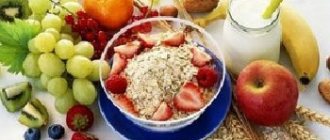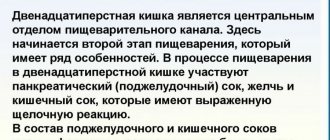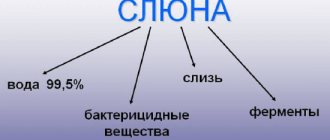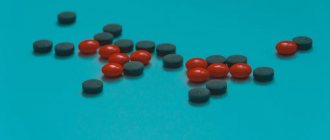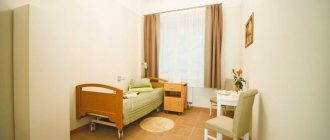Doctors Cost
Price list Doctors clinic
Duodenitis is an inflammation of the mucous membrane of the duodenal wall. There are acute and chronic forms of the disease, they differ in the severity of symptoms. Timely treatment of acute duodenitis allows one to avoid structural changes in tissue, while in chronic cases frequent exacerbations can be observed, and emerging foci of inflammation lead to restructuring of the mucosal structure. Therefore, timely consultation with a doctor in case of severe severe symptoms often helps to avoid unwanted changes.
General rules
Gastroduodenitis is a combined inflammation of the mucous membrane of the lower part (pyloric section) of the stomach and the upper part of the duodenum. It is the anatomical proximity of these organs, and often the commonality of etiological factors (the presence of Helicobacter ), that contributes to the secondary involvement of the duodenal mucosa in the pathological process. This disease is a type of chronic gastritis .
There are acute and chronic forms of the disease, but at the everyday level, most people by gastroduodenitis mean a chronic form of the disease, which lasts for a long time with alternating periods of remissions and exacerbations, which are perceived as “acute gastroduodenitis”.
Diet for gastroduodenitis is the most important component of the treatment process and depends on the form and type of the disease (superficial “catarrhal”, erythematous, erosive gastroduodenitis), as well as gastric pH-metry . The general principles of nutrition for gastritis and duodenitis are: maximum sparing of the mucous membrane of the compromised organ from any type of damaging factors. This is achieved by excluding from the diet foods that require long-term digestion; food is served in a homogenized state (boiled, ground, mushy), and it is also necessary to chew food thoroughly.
It is not allowed to serve food in an excessively hot/cold state. Foods that cause chemical irritation (fatty and fried foods, smoked meats, marinades, spices and sauces, canned food, raw vegetables, alcohol) are excluded from the diet; salt intake is limited.
Causes of the disease
The chronic form is provoked by:
- food allergies;
- infection with parasites (helminths, Giardia);
- certain medications;
- severe constant stress.
In its acute form, the disease manifests itself due to:
- peptic ulcer;
- diseases of the biliary tract;
- chronic gastritis;
- diverticulosis;
- chronic pancreatitis;
- high content of hydrochloric acid and pepsin in gastric juice;
- duodenostasis;
- insufficient secretin production;
- genetic predisposition;
- disturbances of local blood flow;
- intoxication of the body;
- hypoxia of organs and tissues;
- poor quality food, improper diet and/or diet;
- food poisoning;
- acute intestinal infections;
- reduced local immunity.
Varieties
Nutrition for chronic gastroduodenitis is prescribed according to certain schemes, sequentially depending on the form and phase of the disease, the acidity of gastric juice.
Diet for gastroduodenitis in the acute stage
Exacerbation of gastroduodenitis against the background of increased or normal acidity requires the prescription of Diet No. 1 and its varieties. On the first day, complete fasting with small amounts of liquid (boiled water, tea without sugar) is indicated. On days 2-3, the patient is transferred to Table No. 1A .
The energy value of the diet is 1800 kcal. The reduction in calorie content is carried out mainly by reducing the consumption of carbohydrates and, to a small extent, proteins and fats.
Dishes and foods that stimulate secretion and irritate the gastric mucosa are prohibited. Food is steamed or boiled, served pureed or mushy; too hot/cold dishes are not allowed. Salt intake is limited to 6-8 grams.
Meals during bed rest are fractional. Drink about 1.5 liters of liquid. On days 6-8, in order to stimulate regeneration of the gastric/pancreatic mucosa, the patient is transferred to Diet 1B .
Meals while observing semi-bed rest. The energy value is reduced mainly by limiting the amount of carbohydrates, with a normal content of proteins and fats. Soups with mucous broth. Solid, stimulating foods, cold and hot dishes are excluded.
Food is steamed or boiled and served in a homogenized state. Salt is limited. The duration of Diets 1 and 1B is determined by many factors, including the form of gastroduodenitis. Thus, with superficial gastroduodenitis, given that only the mucous membrane is involved in the inflammatory process, and the remaining structures of the stomach and intestines are functionally sufficient and not affected, the period of fasting and dietary nutrition can be relatively short.
With erosive gastroduodenitis , in which there are already defects ( erosions ) on the surface of the mucous membrane, both the duration of fasting and the length of time spent on Diets No. 1A , 1B and No. 1 . In this regard, with gastritis and erosive duodenitis, which is considered a pre-ulcerative condition, it is necessary to more strictly comply with all the requirements of therapeutic nutrition.
Next, Table No. 1 . An energetically and physiologically complete diet without pronounced mechanical sparing. Food is not wiped. The menu includes dishes with various heat treatments - boiled, stewed, baked without crust and degree of grinding. Table salt is limited slightly. Meals are fractional, in reduced portions. As the patient's condition improves, the menu expands.
Salads from boiled vegetables, mild varieties of cheese, doctor's sausage and milk sausage are allowed. Only yesterday's white bread. Among the fats, preference is given to refined olive, sunflower and flaxseed oil. For porridges, rice, oatmeal and buckwheat are recommended. You should avoid pasta. Only dietary meat (chicken, rabbit, turkey). Eggs - in the form of a steam omelet.
A small amount of low-fat cottage cheese is allowed from dairy products. The advisability of including whole milk and cream in the diet is questionable. It is useful to include vegetable juices in your diet. Eating fruits and berries raw is undesirable. New dishes are gradually introduced into the diet, portions are increased, and soon the patient is transferred to Table No. 15 .
Gastroduodenitis in the vast majority of cases occurs against the background of normal/high acidity. In cases of gastroduodenitis in patients with low acidity in the recovery stage, the patient's treatment is adjusted by prescribing Diet No. 2 . In addition to providing the patient with adequate nutrition, its task includes moderate stimulation of the secretory function of the gastrointestinal tract and normalization of the motor function of the intestinal tract. To do this, the diet increases the content of foods rich in fiber and connective tissue, and also expands the types of heat treatment of foods - baked, boiled, stewed, fried without forming a crust.
Rich mushroom, meat and fish broths are allowed. The diet includes sweet and sour vegetables and berries (strawberries, currants, raspberries, lingonberries), citrus fruits, sour dairy products, sauces based on vegetable decoctions (white sauce with lemon, sour cream, mushroom) and spices, parsley, dill, celery. The consumption of butter and refined vegetable oils is increasing. Physiologically, the diet is complete (3000 Kcal). Diet: 4-5 times without overeating. The nutrition menu for hypoacid gastroduodenitis is given in the corresponding section.
Preventive measures
The basis for the prevention of gastrointestinal diseases is a balanced diet. Doctors recommend that patients stop smoking and drinking alcohol. Reducing the risk of developing inflammatory processes in the duodenum is facilitated by timely treatment of pathologies of the digestive system.
In the chronic course of the disease, a child or adult will need to regularly undergo clinical examinations and take medications that help eliminate the cause of inflammation of the intestinal epithelium. In this case, a favorable prognosis is formed - the patient’s quality of life remains at a consistently high level.
Authorized Products
The first courses are prepared mainly slimy and pureed. You can cook it in vegetable or weak meat/fish broth, after which the contents are rubbed through a sieve. Butter is added to prepared soups. Lean beef, chicken, rabbit, lean fish (carp, pike perch) are steamed, boiled or stewed with the addition of water.
Cereals (buckwheat, semolina, rice), as well as turkey and noodles are used as a side dish. Vegetables (cauliflower, potatoes, beets, pumpkin, zucchini, carrots) are served boiled or stewed.
Butter and vegetable oils are added to prepared dishes. Only dried wheat bread and white crackers are allowed. Only steam omelette or soft-boiled eggs.
Sweet fruits can only be in the form of jelly, jellies or compotes. Low-fat cottage cheese can be eaten in its natural form, as well as in the form of soufflés and casseroles. Desserts and drinks include marshmallows, biscuits, jam (non-sour), honey, weak tea with milk, fermented milk products.
Table of permitted products
| Proteins, g | Fats, g | Carbohydrates, g | Calories, kcal | |
Vegetables and greens | ||||
| boiled cauliflower | 1,8 | 0,3 | 4,0 | 29 |
| boiled potatoes | 2,0 | 0,4 | 16,7 | 82 |
| boiled carrots | 0,8 | 0,3 | 5,0 | 25 |
| boiled beets | 1,8 | 0,0 | 10,8 | 49 |
Cereals and porridges | ||||
| buckwheat porridge with milk | 4,2 | 2,3 | 21,6 | 118 |
| semolina porridge with milk | 3,0 | 3,2 | 15,3 | 98 |
| oatmeal with water | 3,0 | 1,7 | 15,0 | 88 |
| white boiled rice | 2,2 | 0,5 | 24,9 | 116 |
Flour and pasta | ||||
| noodles | 12,0 | 3,7 | 60,1 | 322 |
Bakery products | ||||
| white bread crackers | 11,2 | 1,4 | 72,2 | 331 |
Dairy | ||||
| milk 3.2% | 2,9 | 3,2 | 4,7 | 59 |
| condensed milk | 7,2 | 8,5 | 56,0 | 320 |
| cream 15% (low fat) | 2,3 | 15,0 | 3,6 | 161 |
Meat products | ||||
| boiled beef | 25,8 | 16,8 | 0,0 | 254 |
| beef stew | 16,8 | 18,3 | 0,0 | 232 |
Bird | ||||
| boiled chicken breast | 29,8 | 1,8 | 0,5 | 137 |
| boiled chicken drumstick | 27,0 | 5,6 | 0,0 | 158 |
| boiled turkey fillet | 25,0 | 1,0 | — | 130 |
Eggs | ||||
| omelette | 9,6 | 15,4 | 1,9 | 184 |
| soft-boiled chicken eggs | 12,8 | 11,6 | 0,8 | 159 |
Fish and seafood | ||||
| boiled fish | 17,3 | 5,0 | 0,0 | 116 |
Oils and fats | ||||
| vegetable oil | 0,0 | 99,0 | 0,0 | 899 |
| peasant unsalted butter | 1,0 | 72,5 | 1,4 | 662 |
Non-alcoholic drinks | ||||
| water | 0,0 | 0,0 | 0,0 | — |
| black tea with milk and sugar | 0,7 | 0,8 | 8,2 | 43 |
Juices and compotes | ||||
| compote | 0,5 | 0,0 | 19,5 | 81 |
| juice | 0,3 | 0,1 | 9,2 | 40 |
| jelly | 0,2 | 0,0 | 16,7 | 68 |
| * data is per 100 g of product | ||||
Sources
- Practical guide to childhood diseases. Under the general editorship of prof. V. F. Kokolina and A. G. Rumyantsev. Volume II. Gastroenterology of childhood. Ed. S. V. Belmera, A. I. Khavkina, P. L. Shcherbakova. Ed. 2nd, revised and additional M.: Medpraktika-M. 2010.
- Clinical and pathogenetic rationale for the use of lithium salts in the complex treatment of patients with chronic gastroduodenitis. Glushko L.V., Pozur N.Z. Bulletin of OSU No. 12/December, 2006.
- Marshall BJ, Armstrong JA, McGechie DB, Glancy RJ. Attempt to fulfil Koch's postulates for pyloric Campylobacter. Med J Aust. 1985 Apr 15;142(8):436-9. doi: 10.5694/j.1326-5377.1985.tb113443.x. PMID: 3982345.
Fully or partially limited products
Borscht, okroshka, cabbage soup, and mushroom soup are completely excluded. Raw vegetables (cabbage, onions, turnips, spinach, sorrel, radishes, cucumbers), pickled and pickled vegetables, mushrooms, and canned vegetables are not allowed.
You need to give up fatty meats, smoked meats, canned meat and fish. It is forbidden to serve pasta, millet, pearl barley, corn, and barley porridge, as well as legumes as a side dish. You should not eat hot and fatty sauces, mustard, pepper, horseradish, fried or hard-boiled eggs.
Fresh white bread, rye bread and any flour products are prohibited. Avoid unripe and sour fruits and berries, dried fruits, and nuts. Salty cheeses, fatty cottage cheese, sour cream and cream are not allowed. Desserts and drinks include all confectionery, butter dough, chocolate, ice cream, kvass, carbonated drinks, coffee, alcohol. The diet is limited to greens (dill, basil, parsley).
Table of prohibited products
| Proteins, g | Fats, g | Carbohydrates, g | Calories, kcal | |
Vegetables and greens | ||||
| canned vegetables | 1,5 | 0,2 | 5,5 | 30 |
| cucumbers | 0,8 | 0,1 | 2,8 | 15 |
| white radish | 1,4 | 0,0 | 4,1 | 21 |
| celery (root) | 1,3 | 0,3 | 6,5 | 32 |
| beans | 7,8 | 0,5 | 21,5 | 123 |
| garlic | 6,5 | 0,5 | 29,9 | 143 |
Mushrooms | ||||
| mushrooms | 3,5 | 2,0 | 2,5 | 30 |
Nuts and dried fruits | ||||
| nuts | 15,0 | 40,0 | 20,0 | 500 |
| dried fruits | 2,3 | 0,6 | 68,2 | 286 |
Flour and pasta | ||||
| pasta | 10,4 | 1,1 | 69,7 | 337 |
| pancakes | 6,1 | 12,3 | 26,0 | 233 |
| vareniki | 7,6 | 2,3 | 18,7 | 155 |
| dumplings | 11,9 | 12,4 | 29,0 | 275 |
Bakery products | ||||
| wheat bread | 8,1 | 1,0 | 48,8 | 242 |
Confectionery | ||||
| cookie | 7,5 | 11,8 | 74,9 | 417 |
Cakes | ||||
| cake | 4,4 | 23,4 | 45,2 | 407 |
Chocolate | ||||
| chocolate | 5,4 | 35,3 | 56,5 | 544 |
Raw materials and seasonings | ||||
| seasonings | 7,0 | 1,9 | 26,0 | 149 |
| mayonnaise | 2,4 | 67,0 | 3,9 | 627 |
Dairy | ||||
| dairy products | 3,2 | 6,5 | 4,1 | 117 |
| cream 35% (fat) | 2,5 | 35,0 | 3,0 | 337 |
Cheeses and cottage cheese | ||||
| cheese | 24,1 | 29,5 | 0,3 | 363 |
Meat products | ||||
| pork | 16,0 | 21,6 | 0,0 | 259 |
| salo | 2,4 | 89,0 | 0,0 | 797 |
| bacon | 23,0 | 45,0 | 0,0 | 500 |
Sausages | ||||
| smoked sausage | 9,9 | 63,2 | 0,3 | 608 |
Bird | ||||
| fried chicken | 26,0 | 12,0 | 0,0 | 210 |
Alcoholic drinks | ||||
| dry white wine | 0,1 | 0,0 | 0,6 | 66 |
| dry red wine | 0,2 | 0,0 | 0,3 | 68 |
| vodka | 0,0 | 0,0 | 0,1 | 235 |
| cognac | 0,0 | 0,0 | 0,1 | 239 |
| beer | 0,3 | 0,0 | 4,6 | 42 |
| * data is per 100 g of product | ||||
Treatment of chronic gastroduodenitis
Treatment for chronic gastroduodenitis is complex. It includes diet and drug therapy.
In the presence of an infectious component of the disease, anti-Helicobacter therapy is carried out. The patient is prescribed antimicrobial drugs such as amoxicillin and imidazole. To eliminate Helicobacter pylori infection, bismuth preparations are also recommended for 1-2 weeks.
The most important component of treatment is the normalization of the secretory activity of the stomach. So, with increased acidity, proton pump inhibitors (PPIs), for example, drugs with omeprazole, are prescribed. Such drugs inhibit the activity of the protein that transports protons (H+ - an indicator of acidity) outward. For low acidity, medications are prescribed that increase the production of hydrochloric acid in the stomach.
After the course of treatment, control studies are carried out, the infection status is assessed, as well as the condition of the mucous membranes of the stomach and duodenum.
Menu (Power Mode)
Several options for diet table menu No. 1
First option
| Breakfast |
|
| Lunch |
|
| Dinner |
|
| Afternoon snack |
|
| Dinner |
|
| Before bedtime |
|
Second option
| Breakfast |
|
| Lunch |
|
| Dinner |
|
| Dinner |
|
| Before bedtime |
|
Third option
| Breakfast |
|
| Lunch |
|
| Dinner |
|
| Afternoon snack |
|
| Dinner |
|
| Before bedtime |
|
Dietary nutrition during exacerbation of gastroduodenitis is prescribed for 21 days, but depending on the patient’s complaints, individual characteristics of the body and objective examination data, it may vary. The length of time spent on a specific type of diet is determined in each specific case.
Sample menu for exacerbation of hypoacid gastroduodenitis (table No. 2)
Therapeutic nutrition for hypoacid gastroduodenitis is more expanded: the menu includes first courses that are prepared in richer meat/fish, mushroom, vegetable broth (soup, pickle, borscht) with the inclusion of various vegetables, potatoes, and cereals.
Second courses can be prepared using various technologies (boil, fry, bake) in the form of pieces of meat, fish or meatballs and cutlets, vegetables - in the form of casseroles and purees (white cabbage, potatoes, beets, carrots, zucchini, pumpkin, green peas. cauliflower).
The diet includes cottage cheese, various fermented milk products, vegetable and fruit juices diluted with water, bran decoctions, pureed sweet and sour fruits and berries.
Recipes
Here are recipes for preparing some dishes at home.
First meal
Carrot soup
Eggs, carrots, flour, low-fat meat broth, butter.
Boil the carrots in the prepared broth until tender, remove them and grate them on a fine grater. Fry the flour and mix thoroughly with the carrots. Combine the resulting mixture with the broth. Boil, add lightly beaten chicken eggs, add butter.
Vegetable soup with meat broth
Broccoli, carrots, tomatoes, zucchini, meat broth, low-fat sour cream, salt.
Boil vegetables in the prepared broth until tender, add salt and sour cream.
Second courses
Baked fish with mashed potatoes
Any white lean fish, potatoes, butter, salt.
Boil the potatoes, mash, add salt and oil. Bake the condemned pieces of fish in the oven.
Chicken breast with vegetables
Steam the allowed vegetables, cook the chicken breast in a slow cooker, pour in butter.
Desserts and drinks
Berry (fruit) cheesecake
Soft cottage cheese, oatmeal, sweet berries, butter, sweetener egg, gelatin.
Grind the oatmeal in a blender and mix first with the white, and then the yolk and sweetener. Add cottage cheese and mix. Place the resulting mixture in the prepared pan (grease the walls with butter), add the gelatin previously diluted in water, mix and place in the oven for 40 minutes.
Kefir + strawberry drink
Kefir 1%, granulated sugar, strawberries (strawberries).
Rinse the berries thoroughly with water and sort. Cover with sugar for one hour. Pour in kefir and beat with a blender until thick foam. Cool.
Advantages and disadvantages
| pros | Minuses |
|
|
Diagnosis of chronic gastroduodenitis
Diagnosis and treatment of gastroduodenitis is carried out by a gastroenterologist. If this pathology is suspected, the following types of studies are performed:
- Patient interview and physical examination - complaints of discomfort, pain, nausea, belching or heartburn.
- Endoscopic examination. It is performed using a thin endoscope, which is inserted into the stomach through the esophagus. This method is called esophagogastroduodenoscopy. This is an informative study that allows you to identify hypertrophy, atrophy, redness, pallor or thinning of the walls of the stomach and duodenum.
- Endoscopic biopsy. During an endoscopic examination, a small fragment of the mucous membrane is removed. The tissue is then examined under a microscope for the presence of characteristic lesions or atypical cells (to exclude tumor processes).
- Determination of acidity. This is a method of intraventricular pH-metry. The acidity in the body of the stomach and its antrum is measured. The study allows you to establish normal, low or high acidity. This information is extremely important for developing the correct treatment tactics.
- Test for the presence of H. pylori. The pathogen can be identified using a special breath test. PCR is also performed or antibodies to the bacteria are determined.
The patient undergoes a breath test to detect Helicobacter pylori.
Photo: Association of Medicine and Analytics / YouTube Instrumental diagnostics. To visualize the condition of the stomach and intestines, ultrasound (US), radiography, electrogastrography and other research methods are performed.
Important! The manifestations of chronic gastroduodenitis are very similar to the symptoms of other diseases of the digestive system. Therefore, differential diagnosis is important - a series of measures that make it possible to distinguish gastroduodenitis from chronic cholecystitis, pancreatitis, enterocolitis and peptic ulcer.
Comments from nutritionists
For symptoms of gastroduodenitis, treatment with diet is a necessary condition for recovery. During this period, avoid taking non-steroidal anti-inflammatory drugs ( diclofenac , indomethacin , and buprofen , and spirin etc.), which are often prescribed for joint diseases. If there is a need to take them, then it is recommended to take them only after meals.
During an exacerbation, it is mandatory to take aloe and B of nicotinic acid for elderly patients .
Exacerbations of gastroduodenitis in children are often provoked by psycho-emotional factors, therefore, the comprehensive treatment of a child must necessarily include psychotherapy to eliminate stress and nervous overload.
General information about the disease
This inflammatory disease often occurs accompanied by cholecystitis or gastritis . It can also cause problems with the liver, stomach ulcers, and inflammation of the intestines and pancreas. If left untreated for a long time, gastroduodenitis develops, that is, the stomach is also affected.
Duodenitis in children is usually a chronic disease with periods of exacerbations and remissions. As a result, pathological changes in the mucous membrane are formed. The development of the disease is most often provoked by an incorrect diet and a violation of the diet. Sometimes the causes are cardiovascular, pulmonary pathologies, allergic status, giardiasis.
The peculiarity of the disease is its similarity to gastritis, peptic ulcer, damage to the pancreas and biliary tract. Therefore, differential diagnosis is required.
Often in the acute stage, duodenitis causes complications , as in adults: stenosis, duodenostasis, bleeding, perigastritis , disturbance of intestinal motility (the process of contraction of its walls to move feces).
Rarely, the disease is localized to a specific area of the mucosa without spreading. This form is called “bulbit”.
Results and reviews
Dietary nutrition during gastroduodenitis and during periods of its exacerbation allows you to normalize the function of the gastrointestinal tract in the shortest possible time: pain, nausea, a feeling of heaviness, belching of food disappear, the general condition is normalized, and appetite appears.
- “... I have been suffering from gastroduodenitis with high acidity for many years. Any error in nutrition (alcohol, overeating, spicy foods) causes an exacerbation. I started cooking all my food in a double boiler, eliminating spicy and sour foods. The condition has improved significantly. I’ve already adapted.”
- “... After the holidays, belching, pain and heaviness in the stomach appeared. Doctors diagnosed gastroduodenitis. Treatment of symptoms of gastroduodenitis with diet was carried out at home. A month later everything returned to normal. Now, whenever there is an exacerbation, I immediately go on a diet.”
- “... I have a sad experience. After gastroduodenitis, due to the specifics of my work, I ignored the doctors’ recommendations on dietary nutrition and hoped to get by with medications. The result is a duodenal ulcer two months later. So my advice to everyone is don’t ignore your diet.”
- “... When there is an exacerbation of gastroduodenitis, I always save myself with a diet. Usually 2-3 weeks and everything returns to normal.”
Symptoms of duodenitis in a child
The signs of this disease are very diverse and are similar to peptic ulcers. Common symptoms are:
- severe stabbing and cutting paroxysmal pain before eating or 2-3 hours after it, localized in the stomach or right hypochondrium;
- nausea;
- sour belching;
- heartburn;
- vomit;
- sometimes constipation;
- insomnia;
- headache;
- decreased appetite;
- prostration;
- tearfulness, irritability;
- pale skin. Source: A.A. Baranov, P.L. Shcherbakov Current issues in pediatric gastroenterology // Issues of modern pediatrics. 2002. T. 1, No. 1. P. 12-16
In approximately 50% of children, the disease worsens during the off-season.
In the chronic form, a good appetite usually remains. Symptoms include heartburn, sour belching, increased thirst, abdominal pain, white coating on the tongue, and frequent constipation.
The advanced disease is characterized by weakness, rapid fatigue, belching of air, nausea and a feeling of a full stomach after eating, dull weak pain, gas formation, and diarrhea.
